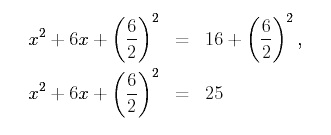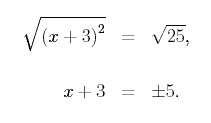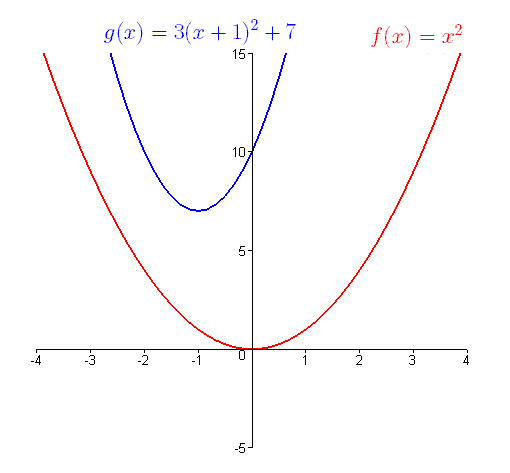Quadratic Functions
Completing the Square
|
Completing the square is a method that can be used to transform a quadratic equation in standard form to vertex form. Once in vertex form, a quadratic equation is easy to graph or solve. The method of completing the square has a few simple steps. The main simplification that we aim to make is to collapse the term,
In other words, these two terms are equal to one another, so we are able to convert from one to the other. The steps to complete the square can be summarized as follows:
We will illustrate each of the steps in completing the square using the following example, y = 2x2 - 8x + 10, a typical quadratic equation in standard form. To complete the square on this equation, we must first isolate the terms involving x as, y − 10 = 2x2− 8x. Next, we make the leading coefficient 1 by dividing both sides of the equation by 2 as,
Now we take half the coefficient of x, square it, and add it to both sides as,
Notice that we have the right hand side in the form,
where k = -4. We collapse the right hand side to
as, x2 - 4x + 4 = (x - 2)2 . Thus, we have,
Solving for y gives, Therefore, we have transformed the equation y = 2x2 - 8x + 10 in standard form to vertex form as,
Completing the Square to Solve Quadratic Equations. Completing the square can also be used to solve quadratic equations. For example, suppose you were asked to solve the equation,
Solving the above equation means to find the values x that make it a true statement. One way to do this is to complete the square. You would follow the same four steps by first isolating all terms involving x,
Next, we make the leading coefficient 1 by multiplying both sides of the equation by 2 as, x2 + 6x = 16. Now take half the coefficient of x, square it, and add it to both sides of the equation as,
Notice that we have the left hand side in the form,
We collapse the left hand side to
as, (x + 3)2 = 25. To solve for x, we take the square root of both sides as,
Thus, we find the solutions of our equation as, x + = 5 − 3 = 2, x − = −5 − 3 = −8. Completing the Square to Help Graph a Quadratic Function Any quadratic function that is not in vertex form can be put in vertex form by completing the square. Once in vertex form, a quadratic equation can be easily plotted by recalling graphical transformations. The function given by, y(x) = a(x − h) 2+ k, can be graphed by transforming the base function f (x) = x2 . For example, g(x) = 3 (x + 1)2− 7 is related to the graph of f (x) = x 2 through the basic transformations. Specifically, the graph of g(x) looks like the graph of f (x) translated to the left 1 unit, stretched vertically by a factor of 3, and finally shifted down by 7.
The domain of all quadratic equations consists of all real numbers. Knowing where the vertex of a parabola lies also allows you to determine the range of that quadratic function. In particular, if the parabola opens upward, the range of the quadratic function f (x) = ax2 + bx + c is,
If the parabola opens downward, the range of the quadratic function f (x) is,
As a specific example, the graph of the function f (x) = −2x2− 4x + 1 has vertex,
Since this parabola opens downward (i.e. a < 0), the range of f (x) is ( −∞, 3]. ***** In the next section we will introduce the quadratic formula, and learn how to find the roots (x-intercepts) of quadratic equations. |
The Biology Project > Biomath > Quadratic Functions> Completing the Square
Department of Biochemistry and Molecular Biophysics
The University of Arizona
January 2006
Contact the Development Team
http://www.biology.arizona.edu
All contents copyright © 2006. All rights reserved.

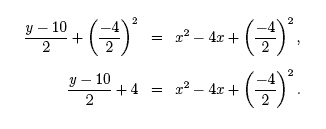

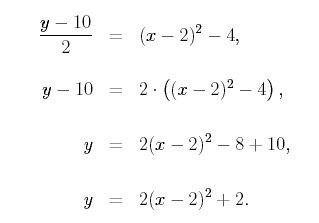
 We can expand the equation y = 2(x − 2)2 + 2 to check our transformation,
We can expand the equation y = 2(x − 2)2 + 2 to check our transformation,


